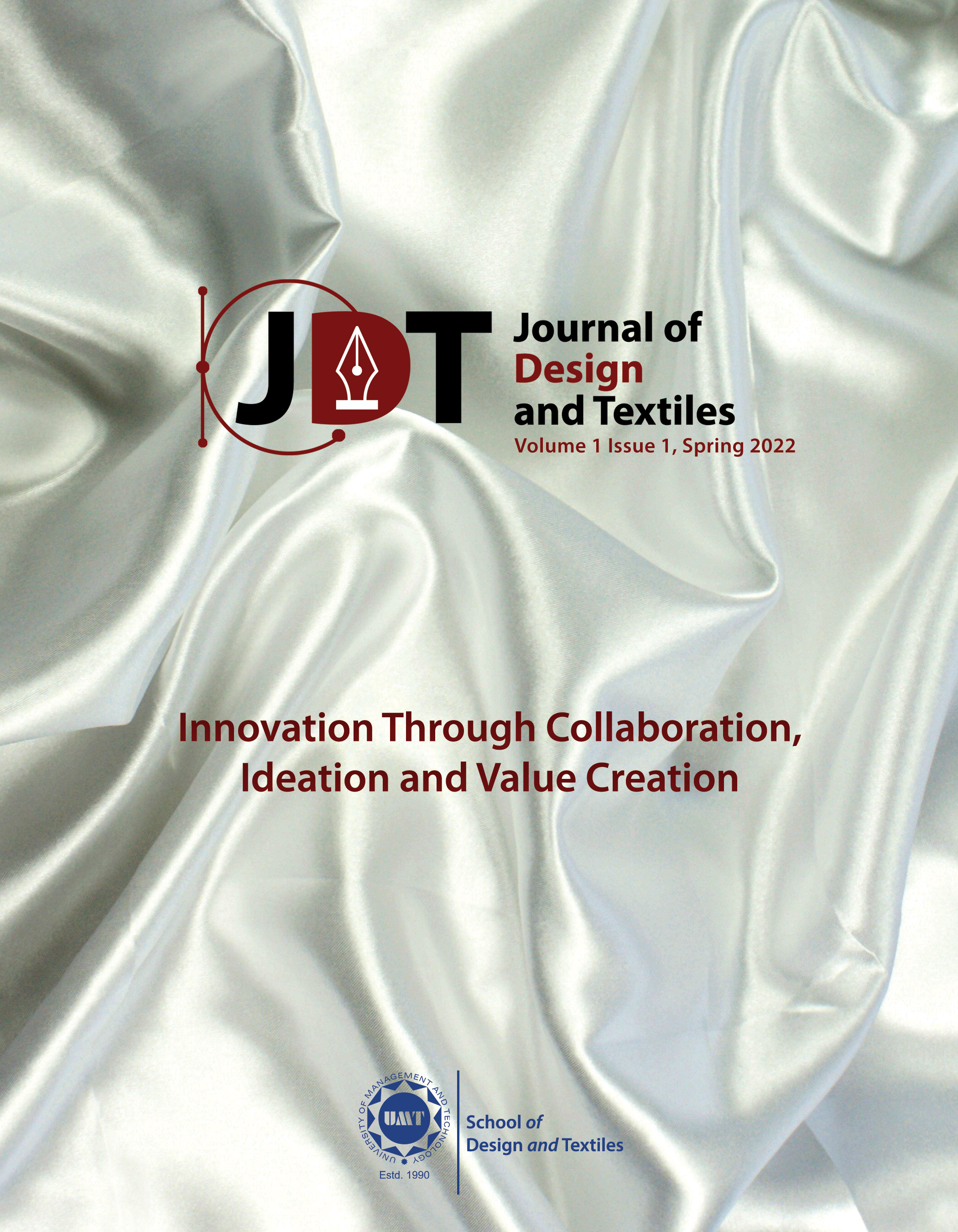Extraction of Natural Dyes from Turmeric (Curcuma longa) and their Application on Polylactic Acid Fiber
Abstract
 Abstract Views: 164
Abstract Views: 164
This research presents an eco-friendly approach towards Response Surface Methodology (RSM). The current study is based on the optimization of the dyeing process of biodegradable polylactic acid (PLA) fiber using with natural dyes of turmeric extractions by using Soxhlet extraction technique. The dyeing process was carried out by using Daelim Starlet III, which is an infrared dyeing machine. Three independent variables were selected, including pH, time, and temperature. According to the standard test protocols, dyed samples were evaluated for color strength (K/S), CIELab values, fiber tenacity, and fiber elongation. ANOVA test results of the Linear Model exhibited that the model terms have a significant effect on K/S and the physical strength of fiber. Moreover, the observed values were in agreement with the predicted values and the suggested equation model was satisfactory and accurate. A temperature of 100 °C with pH 5 and time duration of 30 minutes in the dyeing process were observed to achieve optimum dyed PLA fibers, exhibiting appreciable strength and elongation. Lastly, dyed fibers exhibited satisfactory color fastness ratings.
Index Terms: color strength, exhaustion, natural dyeing, polylactic acid fiber, turmeric
Downloads
References
R. E. Drumright, P.R. Gruber, and D.E. Henton, " Polylactic Acid Technology," Adv. Mater., vol. 12, no. 23, pp. 1841-1846, Dec. 2000, doi: https://doi.org/10.1002/1521-4095(200012)12:23<1841::AID-ADMA1841>3.0.CO;2-E
D. Farrington, et al., "Poly (lactic acid) fibers," in Biodegradable and sustainable fibres, vol. 47, R. Blackburn, Ed., US; Taylor Francis, 2005.
J. Lunt, "Large-scale production, properties and commercial applications of polylactic acid polymers," Polym. Degrad. Stab., vol. 59, no. 1-3, pp.145-152, Jan. 1998, doi: https://doi.org/10.1016/S0141-3910(97)00148-1
B. Gupta, N. Revagade, and J. Hilborn, " Poly (lactic acid) fiber: An overview," Prog. Polym. Sci., vol. 32, no. 4, pp. 455-482, Apr. 2007, doi: https://doi.org/10.1016/j.progpolymsci.2007.01.005
A. Abdrabbo, "The influences of various preparation processes using plasma and enzyme technologies on the properties of poly (lactic acid) fabric," PhD thesis, School Text. Designe, Heriot-Watt Univ., Edinburgh, Scotland, 2012. [Online]. Available: https://www.ros.hw.ac.uk/handle/10399/2679
Y. Osanai, et al., "Cover Picture: Macromol. Biosci. 10/2004," Biotech. letters, vol. 4, no. 10, pp. 909-909, Oct. 2004, doi: https://doi.org/10.1002/mabi.200490022
J.H. Clark and J.J. Hardy, Towards sustainable chemical manufacturing: Polylactic acid–a sustainable polymer. Wiley, 2004.
Y. Matsusue, et al., " In vitro and in vivo studies on bioabsorbable ultra-high-strength poly(L-lactide) rods," J. Biomed. Mater. Res., vol. 26, no. 12, pp. 1553-1567, Dec. 1992, doi: https://doi.org/10.1002/jbm.820261203C
H. Pistner, H. Stallforth, R. Gutwald, J. Mühling, J. Reuther, C. Michela, "Poly (l-lactide): a long-term degradation study in vivo: Part II: physico-mechanical behaviour of implants," Biomaterials, vol. 15, no. 6, pp. 439-450, May 1994, doi: https://doi.org/10.1016/0142-9612(94)90223-2
M. Vert, J. Mauduit, and S. Li, "Biodegradation of PLA/GA polymers: increasing complexity," Biomaterials, vol. 15, no. 15, pp. 1209-1213, Dec. 1994, doi: https://doi.org/10.1016/0142-9612(94)90271-2
E.T. H. Vink, K. R. Rábago, D. A.Glassner, P. R.Gruberb, "Applications of life cycle assessment to NatureWorks™ polylactide (PLA) production," Polym. Degrad. Stab., vol. 80, no. 3, pp. 403-419, 2003, doi: https://doi.org/10.1016/S0141-3910(02)00372-5
Y. Ikada and H. Tsuji, "Biodegradable polyesters for medical and ecological applications," Macromol. Rapid. Commun., vol. 21, no. 3, pp. 117-132, Feb. 2000, doi: https://doi.org/10.1002/(SICI)1521-3927(20000201)21:3<117::AID-MARC117>3.0.CO;2-X
A. Khan, M. T. Hussain, and H. Jiang, "Dyeing of silk fabric with natural dye from camphor (Cinnamomum camphora ) plant leaf extract," Color Technol., vol. 134, no. 4, pp. 266-270, Aug. 2018, doi: https://doi.org/10.1111/cote.12338
L. Hayat and D.A. Jacob, " Dyeing wool and cotton fibres with acidic extract of Hibiscus rosa sinensis flower", Nat. Prod. Res., vol. 33, no. 7, pp. 980-986, May. 2016, doi: https://doi.org/10.1080/14786419.2016.1180598
H. Dhahri, A. Guesmi, and N. Ben Hamadi, " Application of phenolic compounds as natural dye extracted from date-pits: dyeing studies of modified acrylic fibres," Nat. Prod. Res., vol. 33, no. 9, pp. 1329-1333, May. 2018, doi: https://doi.org/10.1080/14786419.2018.1475378
J. Suesat, "Investigation of the influence of fibre morphology on the dyeing and fastness properties of poly (lactic acid)," PhD thesis, Univ. Manchester, Manchester, England, 2004. [Online]. Available: https://ethos.bl.uk/OrderDetails.do?uin=uk.bl.ethos.488220
L.E. Scheyer and A. Chiweshe, " Application and performance of disperse dyes on polylactic acid (PLA) fabric," AATCC Rev., vol. 1, no. 2, pp.44-48, Feb. 2001.
R. S. Blackburn, X. Zhao, D. W. Farrington, L. Johnson, "Effect of d-isomer concentration on the coloration properties of poly(lactic acid)," vol. 70, no. 3, pp. 251-258, 2006, doi: https://doi.org/10.1016/j.dyepig.2005.05.011
D. Phillips, et al., "Influence of different preparation and dyeing processes on the physical strength of the Ingeo fibre component in an Ingeo fibre/cotton blend. Part 1; Scouring followed by dyeing with disperse and reactive dyes," Color. Technol., vol. 120, no. 1, pp. 35-40, June 2004, doi: https://doi.org/10.1111/j.1478-4408.2004.tb00204.x
Y. Yang and S. Huda, "The balance between dyeing and physical properties of PLA," in Proc. Annual Int. Conf. Exhib. AATCC., 2002.
Y. Yang and S. Huda, "Dyeing conditions and their effects on mechanical properties of polylactide fabric," Am. Associ. Text. Chem. Color. Rev., vol. 3, no. 8, pp. 56-61, Aug. 2003.
Copyright (c) 2022 Journal of Design and Textiles

This work is licensed under a Creative Commons Attribution 4.0 International License.

This work is licensed under a Creative Commons Attribution 4.0 International License. Authors retain copyright and grant the journal right of first publication with the work simultaneously licensed under a Creative Commons Attribution (CC-BY) 4.0 License that allows others to share the work with an acknowledgement of the work’s authorship and initial publication in this journal.






